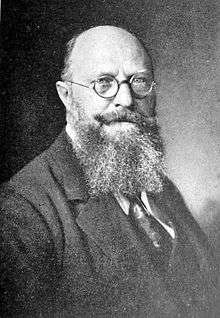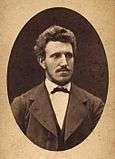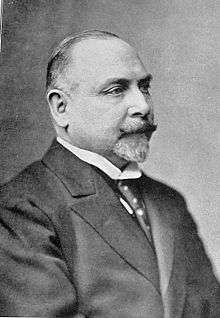Danish Folketing election, April 1920
Danish Folketing election, April 1920

|
|
|
|
All 140 seats to the Folketing
71 seats were needed for a majority |
| |
First party |
Second party |
Third party |
| |
 |
 |
 |
| Leader |
Niels Neergaard |
Thorvald Stauning |
Emil Piper |
| Party |
Venstre |
Social Democrats |
Conservative People's |
| Last election |
45 seats, 29.4% |
39 seats, 28.7 |
22 seats, 18.3% |
| Seats won |
48 |
42 |
28 |
| Seat change |
 3 3 |
 3 3 |
 6 6 |
| Popular vote |
350,563 |
300,345 |
201,499 |
| Percentage |
34.2% |
29.3% |
19.7% |
|
| |
Fourth party |
Fifth party |
| |
 |
|
| Leader |
Carl Theodor Zahle |
? |
| Party |
Social Liberals |
Industry |
| Last election |
32 seats, 20.7% |
1 seat, 1.3% |
| Seats won |
17 |
4 |
| Seat change |
 15 15 |
 3 3 |
| Popular vote |
122,160 |
29,464 |
| Percentage |
11.9% |
2.9% |
|
|
|
Folketing elections were held in Denmark on 26 April 1920,[1] except in the Faroe Islands, where they were held on 20 May.
In what is referred to as Easter Crisis of 1920, on 29 March King Christian X dismissed the government,[2] the Cabinet of Zahle II consisting of members of the Danish Social Liberal Party, replacing it with a caretaker cabinet led by Otto Liebe on 30 March, as he was of the opinion that Central Schleswig should be returned to Denmark regardless of the outcome of the Schleswig Plebiscites. This led to massive protests and was referred to as a coup d'état by the Danish Social Liberal Party and the Social Democratic Party.[3] On 5 April 1920 a compromise was reached, the government was replaced with another caretaker cabinet headed by Michael Pedersen Friis and a new election was to be held as soon as possible.[4]
The election campaign was the most aggressive and bitter in Denmark in the 20th century.[5] Voter turnout was 80.6% in Denmark proper and 58.8% in the Faroe Islands.[6]
Results
Denmark
| Party |
Votes |
% |
Seats |
+/– |
|---|
| Venstre | 350,563 | 34.2 | 48 | +3 |
| Social Democratic Party | 300,345 | 29.3 | 42 | +3 |
| Conservative People's Party | 201,499 | 19.7 | 28 | +6 |
| Danish Social Liberal Party | 122,160 | 11.9 | 17 | –15 |
| Industry Party | 29,464 | 2.9 | 4 | +3 |
| Centre | 9,056 | 0.9 | 0 | New |
| Free Social Democrats | 7,260 | 0.7 | 0 | New |
| Danish Left Socialist Party | 3,859 | 0.4 | 0 | 0 |
| Invalid/blank votes | 3,082 | – | – | – |
| Total | 1,027,288 | 100 | 139 | – |
| Source: Nohlen & Stöver |
Faroe Islands
| Party |
Votes |
% |
Seats |
|---|
| Venstre-Union Party | 3,117 | 64.5 | 1 |
| Independent | 1,717 | 35.5 | 0 |
| Invalid/blank votes | 14 | – | – |
| Total | 4,848 | 100 | 1 |
| Source: Nohlen & Stöver |
References
- ↑ Nohlen, D & Stöver, P (2010) Elections in Europe: A data handbook, p524 ISBN 978-3-8329-5609-7
- ↑ Rosenkrantz, Palle (1934). Den danske regering og rigsdag 1903-1934 (in Danish). Copenhagen: Arthur Jensens Forlag. p. 46.
- ↑ Rosenkrantz. Den danske regering og rigsdag 1903-1934. p. 47.
- ↑ Wendt, Frantz W. (1951). "Rigsdagen 1915-40". In Bomholt, J., Fabricius, K., Hjelholt, H., Mackeprang, M. & Møller, A. (eds.). Den Danske Rigsdag 1849-1949 bind II - Rigsdagens histore 1866-1949 (in Danish). Copenhagen: J. H. Schultz Forlag. p. 388.
- ↑ Wendt. "Rigsdagen 1915-40". Den Danske Rigsdag 1849-1949 bind II - Rigsdagens histore 1866-1949. p. 392.
- ↑ Nohlen & Stöver, p537




